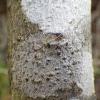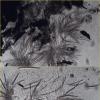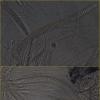
20-12-2025 23:08
Patrice TANCHAUDBonsoir, récolte sur sol sablonneux dans l'arri�

20-12-2025 15:47
Mirek GrycHi.These grew on pine wood that was heavily covere

18-12-2025 21:17
Pol DebaenstThe identification took me to Byssonectria deformi

15-12-2025 07:09
 Danny Newman
Danny Newman
indet. Rutstroemiaceae sp. on unk. fallen leavesMc

19-12-2025 10:10
Patrice TANCHAUDBonjour, récolte réalisée en milieu dunaire, a

18-12-2025 17:23
 Bruno Coué
Bruno Coué
Bonjour,je serais heureux d'avoir votre avis sur c

18-12-2025 18:07
Margot en Geert VullingsThese plumes were found on rotten wood.They strong

17-12-2025 18:35
 Michel Hairaud
Michel Hairaud
Bonjour à tous/Hi to everyone I am passing along
Asci with 8 spores each; The spores are 1-septate when young and then develop other septa, up to 8-septate.
Asci: up to 215 x 12 um;
Spores:
(26.7) 29.2 - 33.7 (34.5) x (6.2) 6.5 - 7.9 (8.1) µm
Q = (3.9) 4 - 4.76 (4.8) ; N = 20
Me = 31.2 x 7.2 µm ; Qe = 4.4,
I will appreciate any hint for the classification.
Thanks in advance,
zaca

In fact, I thought this was a lichen, but I found no trace of an alga.
The last two sets of photos (except for the one on the left hand of the last) were taken after join a drop of melzer to the slide. This permits to see clearly the septation of the spores, which was not possible without it.
Thanks again,
zaca

It is well possible that the asci are inamyloid. Anyhow I would try Lugol for a possible hemiamyloid reaction.
The spores ar very characteristic, I think a lichenologist knows them.
I will follow your suggestions and try a new preparation, whenever possible. If I'll find anything different, it will be reported here.
Thanks,
zaca
Hi Zaca,
Like Zotto, I think it could be a lichen, with leprose thallus.
You can test chemical reactions on the thallus : K, P, C, KC.
How are ascomatas ? Perithecias ? Apothecias ?
Alain
The ascomata are perithecia. I made the spot tests and all chemical reactions were negative. Moreover, did new microscopic observation and found that there seems to be a brown or golden-green alga (perhaps of the genus Trentepohlia). I checked the reference mentioned below and, taking into account the microscopic data, found two genera of pyrenocarpous to which my specimen can belong: Porina or Strigula. I found, in particular, a species _Strigula stigmatella_ with similar features.
Many Thanks to Zotto and to Alain, for their comments that lead me to the possible solution,
zaca
Ref:
Alan Orange, British and Other Pyrenocarpous Lichens, 2013.
(available at: https://www.museumwales.ac.uk/media/13849/Orange,-A.-(2013)-British-and-other-pyrenocarpous-lichens.pdf)




